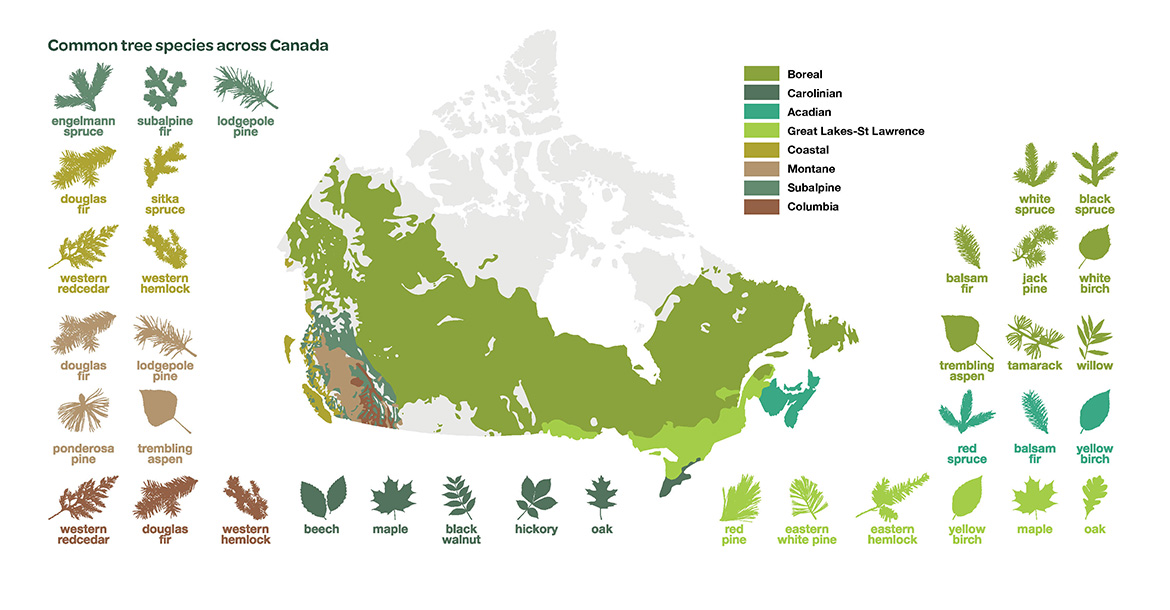
Getting trees in the ground
The 2 Billion Trees program (2BT) shares up-to-date science news and knowledge products with 2BT program recipients and the broader public to inform tree planting projects across the country. Research results and science-based information on tree planting support the selection of trees that provide climate change benefits while achieving key biodiversity, conservation, and human well-being benefits.
Successful tree planting requires procuring seeds, growing seedlings, and preparing planting sites. Tree planting crews transport seedlings to the planting site and plant them in their permanent location.
Planting with your region in mind
Knowing your region and its features (e.g., climate, soil type, and elevation) will help inform what type of trees to plant to increase chances of tree survival. Your ecoregion, forest region, and plant hardiness zone can be used to inform species choice. Consider planting native species as part of your planting strategy, as native species are more likely to survive and can offer the greatest ecological benefit.

Text version
A diagram of Canada showing the eight different forest types across the country.
The Boreal forest is the largest region, extending all the way to western Canada. The Boreal forest region contains 8 tree species:
- white spruce
- black spruce
- balsam fir
- jack pine
- white birch
- trembling aspen
- tamarack
- willow
The Carolinian forest of southern Ontario contains:
- beech
- maple
- black walnut
- hickory
- oak
The Acadian region of Atlantic Canada contains:
- red spruce
- balsam fir
- yellow birch
The Great Lakes-St. Lawrence forest of southern Quebec and central Ontario contains:
- red pine
- eastern white pine
- eastern hemlock
- yellow birch
- maple
- oak
Western Canada consists of Coastal, Montane, Subalpine, and Columbia forests.
The Coastal region contains:
- Douglas fir
- Sitka spruce
- western redcedar
- western hemlock
The Montane region contains:
- Douglas fir
- lodgepole pine
- ponderosa pine
- trembling aspen
The Subalpine region contains:
- Engelmann spruce
- subalpine fir
- lodgepole pine
The Columbia region contains:
- western redcedar
- Douglas fir
- western hemlock
Planting for a changing climate

The climate is changing faster than ever before, and tree species may not be able to genetically adapt or migrate quickly enough to adjust to this change. The rapid pace of climate change makes Canada’s forests more vulnerable to threats, such as forest fires, insects and diseases.
Given the risk that climate change poses, organizations planting trees should consider strategic tree planting for biodiversity and climate resilience. This may mean opting for a greater diversity of plant species, or selecting species that are found further south of a given region.
Organizations planning their planting project should consider planting the right trees (accounting for both species and genetic diversity) in the right places with the proper methods. This is necessary to ensure planted trees survive under continued climate change and can sequester carbon for decades to come.
Sharing knowledge to support the 2 Billion Trees program
The 2BT program is committed to providing program recipients with the knowledge they need to succeed. Below is a list of research projects, knowledge exchange products, tools and activities that have been developed or are in the process of being developed to support tree planting under the program and enhance the survival and productivity of planted trees.
Research projects:
- Tree planting 101 in the Northwest Territories (seismic lines)
- Planting the right trees in the right places for co-benefits to water resources
- Identification of species-specific genetic determinants that increase tree flammability
- Planting the “climate-smart” tree in the right place
- Indigenous guidance to plant the right trees in the right places
Knowledge exchange products, tools and activities:
- PlantR: Plant Community Generator for Restoration
- Grow a green future: A guide for successful tree planting
Research results and other knowledge will become available on an ongoing basis and will be added to the 2BT knowledge inventory.
Stay connected
If you have questions or want to join the distribution list for program updates, email the 2BT program.
- 2BT knowledge inventory (Canadian Forest Service publications)
- Canada’s Plant Hardiness: A website containing hardiness zone maps and maps of future climate habitats for thousands of plant species across Canada.
- Canadian Conservation and Land Management
- Science supporting the 2 Billion Trees program
- 2 Billion Trees Program
- 2 Billion Trees Commitment
- 2 Billion Trees Program - 2021–2022 Showcase Projects
- Tools and resources to support forest adaptation to climate change
- The State of Canada’s Forests Annual Report